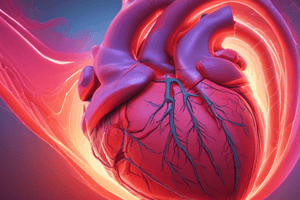Podcast
Questions and Answers
What are concerning findings in a client with heart failure?
What are concerning findings in a client with heart failure?
- Hypoxemia
- Crackles with auscultation
- Abnormal heart tones
- All of the above (correct)
What does hypoxemia indicate in a client with heart failure?
What does hypoxemia indicate in a client with heart failure?
Inadequate gas exchange
Crackles with auscultation are a common finding in patients with heart failure.
Crackles with auscultation are a common finding in patients with heart failure.
True (A)
An S3 heart tone is characteristic of __________.
An S3 heart tone is characteristic of __________.
What should be assessed after cardiac catheterization?
What should be assessed after cardiac catheterization?
What are common signs and symptoms of deep venous thrombosis (DVT)?
What are common signs and symptoms of deep venous thrombosis (DVT)?
BTNP release is a response to increased intraventricular volume.
BTNP release is a response to increased intraventricular volume.
What is the preferred position immediately following cardiac catheterization?
What is the preferred position immediately following cardiac catheterization?
Hypertension is not a concern for clients with heart failure.
Hypertension is not a concern for clients with heart failure.
Flashcards are hidden until you start studying
Study Notes
Life-threatening Symptoms for Cardiac Clients
- Decreased oxygen saturation indicates inadequate gas exchange, which is a potential sign of worsening heart failure.
- Crackles in the lungs can occur due to pulmonary edema from fluid buildup in the alveoli.
- An S3 heart tone signifies rapid blood entry into the ventricle during diastole.
- Hypertension increases cardiac workload, which is concerning for weakened heart muscles.
- Peripheral edema suggests fluid volume overload that can worsen heart failure symptoms.
Heart Failure Exacerbation
- Crackles and decreased oxygen saturation indicate pulmonary edema impairing gas exchange.
- Elevated BNP levels are a response to increased intraventricular volume and stretch.
- A low left ventricular ejection fraction implies a failing left ventricle.
Venous Air Embolism Management
- The upright position can promote air bubbles to travel toward the brain or heart.
- The left lateral decubitus position and Trendelenburg position trap air bubbles in less dangerous areas.
Considerations Following Femoral Cardiac Catheterization
- Clients should remain supine with the head of the bed at ≤ 30 degrees.
- Prevent hip flexion to minimize bleeding risk.
- Palpate pedal pulses bilaterally to assess perfusion.
- Direct pressure on the insertion site can control minor bleeding.
- Report chest pain immediately to the healthcare provider.
Deep Venous Thrombosis (DVT)
- Risk factors for DVT include age over 65, immobility, obesity, and oral contraceptive use.
- Typical symptoms of DVT include edema, localized pain, warmth, and redness of the affected extremity.
Studying That Suits You
Use AI to generate personalized quizzes and flashcards to suit your learning preferences.




